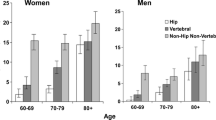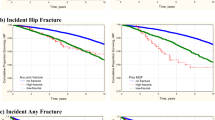Abstract
Osteoporosis management is suboptimal even for high-risk people with a history of prior fracture. There is also evidence that individuals with moderate trauma fracture have a lower bone density and are at higher risk of subsequent fracture. This study aimed to define factors influencing the management of individuals at risk for osteoporosis and to examine the risk profiles of individuals with minimal and moderate trauma fractures. Consecutive fracture patients ( n =218) treated in the outpatient fracture clinic in St Vincent’s Hospital, Sydney, over a 15-month period (February 2002–July 2003) were interviewed. Fracture risk factors, prior investigation and treatment for osteoporosis were collected and participants were contacted after 3 months to ascertain follow-up. Risk factors for osteoporosis including family history, low dietary calcium and conditions associated with bone loss were similar between low- and moderate-trauma groups and between sexes. Even though half of participants had had a prior fracture, only 34% had a bone density scan and 16% were on anti-resorptive treatment. There was a minimal (6%) increase in the rates of investigation and treatment at the 3-month follow-up, and less in the moderate trauma group and males. Independent predictors for being investigated for osteoporosis were: age over 50, prior fracture and female gender, while predictors for treatment were: age over 50 and having been investigated. This study has confirmed low rates of investigation and treatment even in individuals who have already suffered a prior fracture, and especially in those <50 and in males. People with moderate and minimal trauma fractures had similar risk factors for osteoporosis, including a similarly high proportion of prior fractures. These findings support the concept that people with moderate trauma fractures are at higher subsequent fracture risk, yet are neither investigated nor treated. This study highlights the need for further exploration of barriers to osteoporosis management.
Similar content being viewed by others
References
Melton LJ 3rd (2003) Adverse outcomes of osteoporotic fractures in the general population. J Bone Miner Res 18:1139–1141
Cooper C (1997) The crippling consequences of fractures and their impact on quality of life. Am J Med 103:12S–19S
Randell A, Sambrook PN, Nguyen TV, Lapsley H, Jones G, Kelly PJ, Eisman JA (1995) Direct clinical and welfare costs of osteoporotic fractures in elderly men and women. Osteoporos Int 5:427–432
Sanders KM, Nicholson GC, Ugoni AM, Pasco JA, Seeman E, Kotowicz MA (1999) Health burden of hip and other fractures in Australia beyond 2000. Projection on the Geelong Osteoporosis Study. Med J Aust 170:467–470
The burden of brittle bones: costing osteoporosis in Australia (2001) Access Economics, Canberra
Sanders KM, Seeman E, Ugoni AM, Pasco JA, Martin TJ, Skoric B, Nicholson GC, Kotow A (1999) Age- and gender-specific rate of fractures in Australia: a population-based study. Osteoporos Int 10:240–247
Sambrook PN, Seeman E, Phillips SR, Ebeling PR (2002) Preventing osteoporosis: outcomes of the Australian Fracture Prevention Summit. Med J Aust 176:S1–S16
Doherty DA, Sanders KM, Kotowicz MA, Prince RL (2001) Lifetime and five-year age-specific risks of first and subsequent osteoporotic fractures in postmenopausal women. Osteoporos Int 12:16–23
Van Staa TP, Leufkens HG, Cooper C (2002) Does a fracture at one site predict later fractures at other sites? A British cohort study. Osteoporos Int 13:624–629
Mallmin H, Ljunghall S, Persson I, Naessen T, Krusemo UB, Bergstrom R (1993) Fracture of the distal forearm as a forecaster of subsequent hip fracture: a population-based cohort study with 24 years of follow-up. Calcif Tissue Int 52:269–272
Robinson CM, Royds M, Abraham A, McQueen MM, Court-Brown CM, Christie J (2002) Refractures in patients at least forty-five years old. A prospective analyses of twenty-two thousand and sixty patients. J Bone Joint Surg Am 84:1528–1533
Klotzbuecher CM, Ross PD, Landsman PB, Abbott TA 3rd, Berger M (2000) Patients with prior fractures have an increased risk of future fractures: a summary of the literature and statistical synthesis. J Bone Miner Res 15:721–739
Diamond T, Sambrook P, Williamson M, Flicker L, Nowson C, Fiatarone-Singh M, Lord S, Ferris L, O’Neil S, MacLennan A (2001) Guidelines for treatment of osteoporosis in men. Aust Fam Physician 30:787–791
Kanis JA, Black D, Cooper C, Dargent P, Dawson-Hughes B, De Laet C, Delmas P, Eisman J, Johnell O, Jonsson B, Melton L, Oden A, Papapoulos S, Pols H, Rizzoli R, Silman A, Tenenhouse A, on behalf of the International Osteoporosis Foundation and the National Osteoporosis Foundation USA (2002) A new approach to the development of assessment guidelines for osteoporosis. Osteoporos Int 13:527–536
Sanders KM, Pasco JA, Ugoni AM, Nicholson GC, Seeman E, Martin TJ, Skoric B, Panahi S, Kotowicz MA (1998) The exclusion of high trauma fractures may underestimate the prevalence of bone fragility fractures in the community: The Geelong Osteoporosis study. J Bone Miner Res 13:1337–1342
Karlsson MK, Hasserius R, Obrant KJ (1993) Individuals who sustain nonosteoporotic fractures continue to also sustain fragility fractures. Calcif Tissue Int 53:229–231
Simonelli C, Chen YT, Morancey J, Lewis AF, Abbott AT (2003) Evaluation and management of osteoporosis following hospitalization for low-impact fracture. J Gen Intern Med 18:17–22
Bellantonio S, Fortinsky R, Prestwood K (2001) How well are community-living women treated for osteoporosis after hip fracture? J Am Geriatr Soc 49:1197–1204
Hajcsar E, Hawker G, Bogoch ER (2000) Investigation and treatment of osteoporosis in patients with fragility fractures. CMAJ 163:819–822
Port L, Center J, Briffa KN, Nguyen T, Cumming R, Eisman J (2003) Osteoporotic fracture: missed opportunity for intervention. Osteoporos Int 14:780–784
Smith M, Ross W, Ahern MJ (2001) Missing a therapeutic window of opportunity: an audit of patients attending a tertiary teaching hospital with potentially osteoporotic hip and wrist fractures. J Rheumatol 28:2504–2508
Wong PK, Spencer DG, McElduff P, Manolios N, Larcos G, Howe GB (2003) Secondary screening for osteoporosis in patients admitted with minimal-trauma fracture to a major teaching hospital. Intern Med J 33:505–510
Castel H, Bonneh DY, Sherf M, Liel Y (2001) Awareness of osteoporosis and compliance with management guidelines in patients with newly diagnosed low-impact fractures. Osteoporos Int 12:559–564
Panneman MJ, Lips P, Sen SS, Herings RM (2003) Undertreatment with anti-osteoporotic drugs after hospitalization for fracture. Osteoporos Int 15:120–124
Briancon D, de Gaudemur JB, Forestier R (2004) Management of osteoporosis in women with peripheral osteoporotic fractures after 50 years of age: a study of practices. Joint Bone Spine 71:128–130
Sidwell AI, Wilkinson TJ, Hanger HC (2004) Secondary prevention of fractures in older people: evaluation of a protocol for the investigation and treatment of osteoporosis. Intern Med J 34:129–132
Taylor JC, Sterkel B, Utley M, Shipley M, Newman S, Horton M, Fitz-Clarence H (2001) Opinions and experiences in general practice on osteoporosis prevention, diagnosis and management. Osteoporos Int 12:844–848
Cuddihy MT (2003) Barriers to osteoporosis care in postmenopausal women J Gen Intern Med 18:70–71
Mauck KF, Cuddihy MT, Trousdale RT, Pond GR, Pankratz VS, Melton LJ 3rd (2002) The decision to accept treatment for osteoporosis following hip fracture: exploring the woman’s perspective using a stage-of-change model. Osteoporos Int 13:560—564
Acknowledgments
The authors acknowledge Dr. Tuan Nguyen’s assistance and advice with data analyses. We would like to thank the Orthopaedic Department and the staff from St Vincent’s Hospital Fracture Clinic for their support with data collection. We are grateful to the participants for their essential contribution to this study
Author information
Authors and Affiliations
Corresponding author
Rights and permissions
About this article
Cite this article
Bliuc, D., Ong, C.R., Eisman, J.A. et al. Barriers to effective management of osteoporosis in moderate and minimal trauma fractures: a prospective study. Osteoporos Int 16, 977–982 (2005). https://doi.org/10.1007/s00198-004-1788-x
Received:
Accepted:
Published:
Issue Date:
DOI: https://doi.org/10.1007/s00198-004-1788-x




